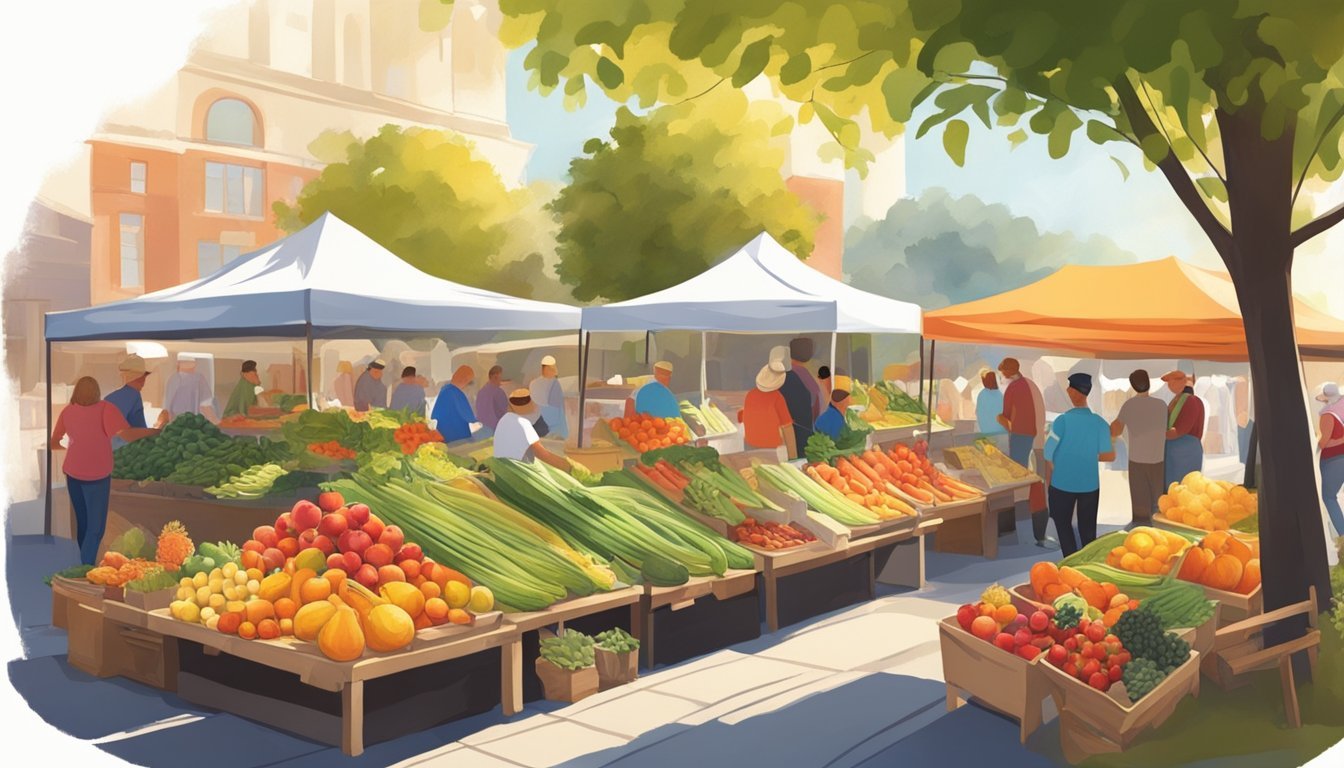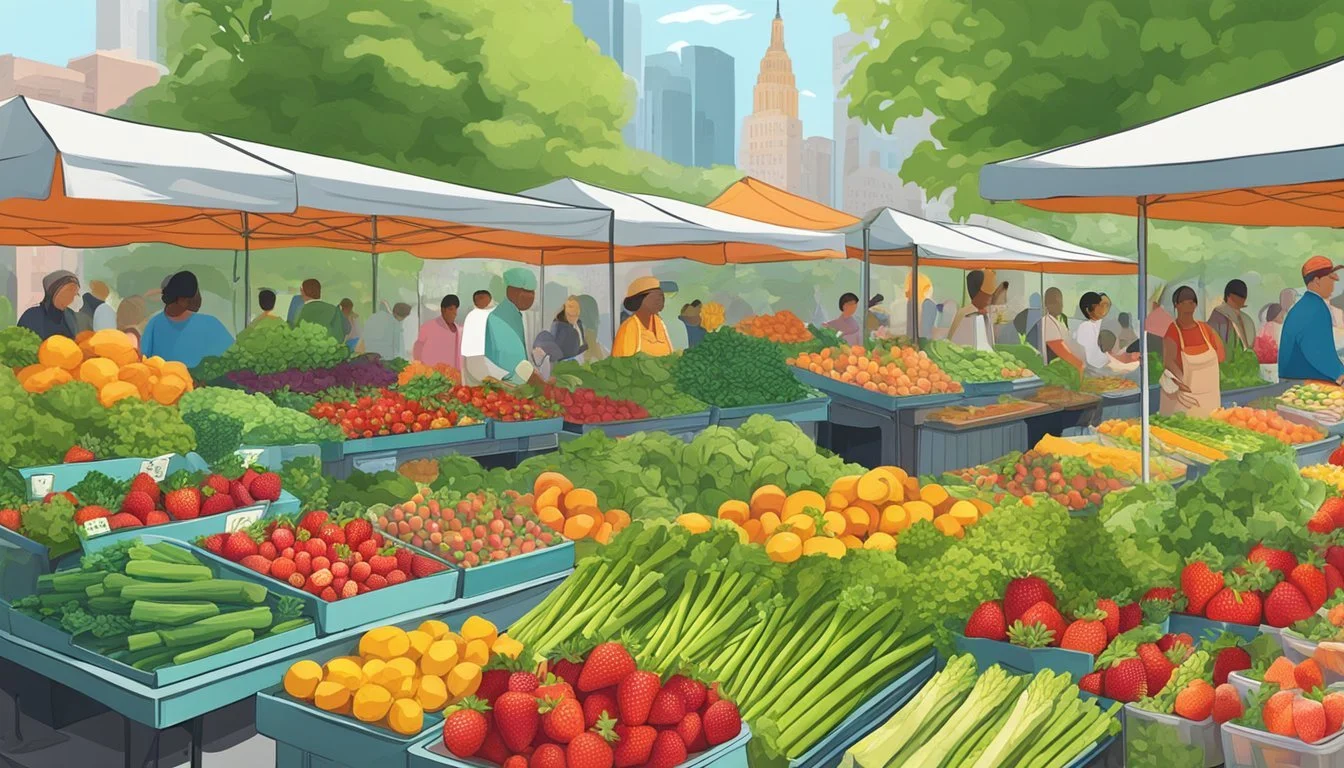New York Seasonal Fruit & Vegetables in May
A Fresh Guide to Local Produce
This Article is Part of our New York Seasonal Fruit & Veg Calendar
As spring reaches its peak in New York, the month of May heralds a fresh selection of seasonal fruits and vegetables ripe for the picking. This time of year is characterized by a tangible shift in the variety and flavors available at local farmers' markets and grocers. Eating locally produced food not only supports New York farmers but also provides consumers with produce that is often fresher and packed with more nutrients due to the reduced time between harvest and consumption.
Seasonal eating in May brings an array of produce that New Yorkers eagerly anticipate after the long winter months. Leafy greens such as spinach (What wine goes well with spinach?) and kale flourish in the mild weather, while vibrant rhubarb stalks and asparagus (What wine goes well with asparagus?) spears make their seasonal debut. Root vegetables, which have been staples throughout the cooler seasons, begin to make room for the likes of spring onions and radishes, offering a crisp, fresh taste that is synonymous with spring.
Fruits, while not as abundant as vegetables during this month, start to hint at the sweet bounty that summer will bring. Strawberries, a cherished favorite, slowly start to appear, promising the sweet, juicy flavors that peak in the following months. New York's focus on seasonal consumption in May creates a culinary transition period, where the lingering root vegetables and hearty greens of winter begin to give way to the lighter, crisper textures and flavors that epitomize spring.
What's In Season
In May, New York's harvest calendar is ripe with freshness and variety, offering a delightful selection of fruits and vegetables. Farmers and gardeners busy themselves as the spring weather nurtures growth, signaling that it's time to enjoy the delectable produce at its peak.
Fruits:
Strawberries: Known for their sweet and juicy flavor, they are a highlight of the seasonal bounty.
Vegetables:
Arugula: This peppery leafy green elevates salads with its distinct taste.
Asparagus: A versatile vegetable known for its succulent texture and earthy tones.
Chard: Rich in nutrients, chard can be sautéed or used in hearty soups.
Fava Beans: (how long do fava beans last?) With a buttery texture, they are great in salads or as a side dish.
Green Onions/Scallions: They provide a mild kick to dishes, used both raw and cooked.
Lettuce: A salad staple, offering varieties from butterheads to crisp romaines.
Mint: An aromatic herb, mint is perfect for infusing freshness into drinks and dishes.
During this month, markets brim with these selections. Patrons can expect that these items have likely been harvested recently, promising optimal taste and nutritional value. The month of May truly marks an opportune moment to savor the early gifts of New York's agricultural efforts.
Spring Harvest in New York
The month of May marks a vibrant period for New York's agriculture, as a variety of produce reaches maturity and becomes ready for harvest. This is a prime time for consumers to enjoy fresh, locally-grown fruits and vegetables.
Fruits
Strawberries: One of the first fruits to signal the start of the warmer months, strawberries typically begin their harvest season in late May.
Vegetables
Asparagus: The asparagus harvest commences in May, offering its tender shoots.
Beets: Root vegetables like beets are available and can be found fresh in the markets.
Lettuce: Various types of lettuce reach maturity, adding a crisp freshness to spring salads.
Spinach: Known for its versatility, spinach is another leafy green harvested during this time.
Kale: A hardy green, kale is also typically ready for harvest in May.
Rhubarb: While often used in culinary applications similar to fruit, rhubarb is a vegetable that is commonly harvested in May.
Health Benefits of Seasonal Eating
Consuming seasonal fruits and vegetables ensures that individuals are getting fresh produce at the height of its nutritional value. Foods grown and picked at their peak generally contain more vitamins and antioxidants.
Here are key benefits of seasonal eating:
Enhanced Flavor and Nutrition: Seasonal produce often tastes better. It has been allowed to ripen fully in the field, leading to a richer flavor and higher nutritional content.
Diversity in Diet: Eating seasonally introduces a wider variety of nutrients to one’s diet, as different produce offer different vitamins and minerals.
Supports Local Agriculture: Purchasing produce that is in season locally supports regional farmers and reduces the carbon footprint associated with long-distance food transport.
Seasonal Eating Health Impact Freshness and Ripeness Higher vitamin and mineral content Varied Diet Access to a broader range of nutrients Support for Local Farms Lower environmental impact Peak Flavor Greater enjoyment and satisfaction
By choosing seasonal foods, consumers can enjoy the health benefits associated with consuming fruits and vegetables filled with the optimum amount of nutrients. This approach to diet helps support one's overall health and wellbeing.
Harvesting and Storage Tips
Proper harvesting and storage techniques are essential for maintaining the quality and longevity of fruits and vegetables. Attention to detail during these processes ensures that the produce retains its optimal taste and nutritional value.
Fruit Handling
Strawberries
To harvest strawberries, one should pick them when they are fully red, as they do not continue to ripen after being picked. Strawberries should be stored in the refrigerator and not washed until just before use to prevent mold.
Rhubarb
When harvesting rhubarb, select the firm, crisp stalks and trim away the leaves, which are toxic. Rhubarb is best kept in a cool, dark place and can be wrapped in plastic and refrigerated for up to a week.
Apples
Apples can be picked from the trees when their color has fully developed and they separate easily from the branch. For storage, apples prefer a cool environment around 32°F with high humidity to prevent shriveling.
Vegetable Care
Asparagus
Asparagus should be snapped off at ground level when they are about 6 to 8 inches tall. To store, it is ideal to keep asparagus upright in a container with water at the bottom, or wrapped in a damp cloth and placed in the refrigerator.
Lettuce
Lettuce leaves are ready to harvest when they're firm and vibrant. After harvesting, lettuce should be stored in the refrigerator and can be kept crisp by wrapping in a damp paper towel.
Spinach
For spinach, leaves are best when tender and bright green. After cutting, spinach can be stored in the fridge in a container lined with paper towels to absorb excess moisture.
Farmers Markets and CSAs
Farmers markets in New York during May are bustling with activity, as local farms begin to showcase the fruits of their labor. These markets are prime locations for consumers to access fresh, seasonal produce directly from the source. Shoppers can enjoy a variety of locally grown fruits and vegetables, which might include tender salad greens, crisp radishes, and the first strawberries of the season.
Community Supported Agriculture (CSA) programs are also in full swing, with local farms offering shares of their harvest. Members typically receive a weekly box of fresh produce, which supports the farm financially while providing consumers with a regular supply of seasonal food.
CSA Benefits:
Supports Local Farmers: By committing to a CSA, members provide farms with a stable income.
Seasonal Variety: Shares often include a diverse selection of produce, reflecting the season's bounty.
Freshness: Produce is harvested at its peak, ensuring maximum freshness and flavor.
Finding a Market or CSA: Consumers can visit websites like GrowNYC to find information on farmers markets and available produce. For those interested in CSAs, LocalHarvest provides details on shares, which may include not just vegetables but also fruit, eggs, and other farm products.
Sample of May Produce:
Strawberries
Radishes
Salad Greens
Asparagus
It's important for buyers to remember that availability may vary based on growing conditions and specific farms. Visiting a local farmers market or researching CSAs is the best way to discover what's currently available and to enjoy the season’s offerings.
Seasonal Recipes
In May, New York's local produce offers a bounty of fresh ingredients, ideal for creating delightful and nutritious recipes. Chefs and home cooks alike take advantage of the season's harvest, featuring strawberries and asparagus as prominent components in their cooking.
Strawberry Recipes:
Salad: Fresh strawberries can add a sweet note to salads. Mix them with spinach, goat cheese, and a balsamic vinaigrette.
Dessert: Strawberry shortcake is a springtime favorite, with layers of sponge cake, strawberries, and whipped cream.
Jam: Homemade strawberry jam is perfect for preserving the flavor of the season.
Grilled Asparagus (What wine goes well with grilled asparagus?) : A quick drizzle of olive oil and a sprinkle of salt, then grill for a smoky side dish.
Asparagus Risotto: Creamy risotto pairs excellently with the crisp texture of sautéed asparagus.
Pickled Asparagus: Pickling asparagus is a unique way to enjoy it as a snack or in salads.
These ingredients transcend the raw state in recipes such as strawberry vinaigrette or as a roasted element side-by-side with other seasonal vegetables. Utilizing local produce not only supports regional agriculture but also ensures peak flavor and nutrition. It is encouraged that cooks explore farmers' markets to source the freshest ingredients for their May recipes.
Growing Your Own
May in New York presents an excellent opportunity for gardeners to start growing a variety of fruits and vegetables. The risk of frost has typically passed, which means gardeners can begin transplanting seedlings that were started indoors to their outdoor gardens.
Herbs such as basil, cilantro, and parsley thrive in May's mild temperatures and can be sown directly into the garden. These aromatic plants not only provide fresh flavors for the kitchen but also attract beneficial pollinators to the garden.
Here is a simple guide to what crops can be planted in May:
Type Examples Vegetables Tomatoes, bell peppers, cucumbers, zucchini Leafy Greens Lettuce, spinach, Swiss chard Root Vegetables Carrots, beets, radishes Fruits Strawberries (as plants), melons (seed or transplant)
When planting, gardeners should ensure proper spacing to provide enough room for growth. For example, tomatoes should be spaced about 2 feet apart, while carrots can be sown in rows with seeds placed a few inches apart.
For those interested in permaculture or no-till gardening, May is a good time to establish or maintain these systems. By focusing on soil health and minimizing disturbance, gardeners can create a sustainable environment for crops to flourish throughout the growing season.
As plants grow, consistent watering and the use of mulch to retain soil moisture are critical. Gardeners may also begin to set up support structures for vining crops such as cucumbers and tomatoes if not done so already.
Careful attention to these practices ensures that by mid-summer, gardens will be brimming with fresh produce ready for harvest.








